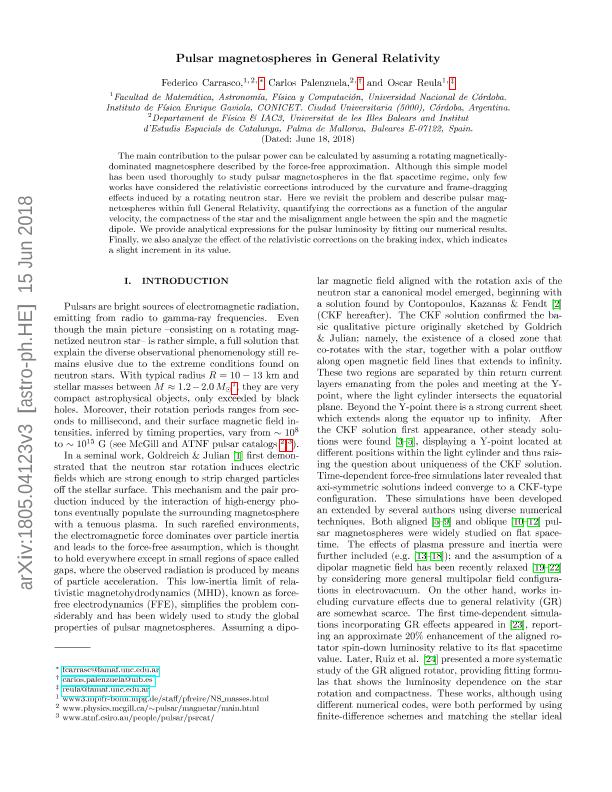Mostrar el registro sencillo del ítem
dc.contributor.author
Carrasco, Federico León

dc.contributor.author
Palenzuela, Carlos
dc.contributor.author
Reula, Oscar Alejandro

dc.date.available
2019-12-06T22:01:50Z
dc.date.issued
2018-07
dc.identifier.citation
Carrasco, Federico León; Palenzuela, Carlos; Reula, Oscar Alejandro; Pulsar magnetospheres in general relativity; American Physical Society; Physical Review D; 98; 2; 7-2018; 1-19
dc.identifier.issn
2470-0010
dc.identifier.uri
http://hdl.handle.net/11336/91687
dc.description.abstract
The main contribution to the pulsar power can be calculated by assuming a rotating magnetically dominated magnetosphere described by the force-free approximation. Although this simple model has been used thoroughly to study pulsar magnetospheres in the flat spacetime regime, only a few works have considered the relativistic corrections introduced by the curvature and frame-dragging effects induced by a rotating neutron star. Here, we revisit the problem and describe pulsar magnetospheres within full general relativity, quantifying the corrections as a function of the angular velocity, the compactness of the star, and the misalignment angle between the spin and the magnetic dipole. We provide analytical expressions for the pulsar luminosity by fitting our numerical results. Finally, we also analyze the effect of the relativistic corrections on the braking index, which indicates a slight increment in its value.
dc.format
application/pdf
dc.language.iso
eng
dc.publisher
American Physical Society

dc.rights
info:eu-repo/semantics/openAccess
dc.rights.uri
https://creativecommons.org/licenses/by/2.5/ar/
dc.subject
FORCE FREE
dc.subject
PULSARS
dc.subject
MAGNETOSPHERE
dc.subject
RELATIVISTIC
dc.subject.classification
Astronomía

dc.subject.classification
Ciencias Físicas

dc.subject.classification
CIENCIAS NATURALES Y EXACTAS

dc.title
Pulsar magnetospheres in general relativity
dc.type
info:eu-repo/semantics/article
dc.type
info:ar-repo/semantics/artículo
dc.type
info:eu-repo/semantics/publishedVersion
dc.date.updated
2019-10-22T16:37:45Z
dc.identifier.eissn
2470-0029
dc.journal.volume
98
dc.journal.number
2
dc.journal.pagination
1-19
dc.journal.pais
Estados Unidos

dc.journal.ciudad
Washington DC
dc.description.fil
Fil: Carrasco, Federico León. Consejo Nacional de Investigaciones Científicas y Técnicas. Centro Científico Tecnológico Conicet - Córdoba. Instituto de Física Enrique Gaviola. Universidad Nacional de Córdoba. Instituto de Física Enrique Gaviola; Argentina. Universidad Nacional de Córdoba. Facultad de Matemática, Astronomía y Física; Argentina
dc.description.fil
Fil: Palenzuela, Carlos. Universidad de las Islas Baleares; España
dc.description.fil
Fil: Reula, Oscar Alejandro. Consejo Nacional de Investigaciones Científicas y Técnicas. Centro Científico Tecnológico Conicet - Córdoba. Instituto de Física Enrique Gaviola. Universidad Nacional de Córdoba. Instituto de Física Enrique Gaviola; Argentina. Universidad Nacional de Córdoba. Facultad de Matemática, Astronomía y Física; Argentina
dc.journal.title
Physical Review D
dc.relation.alternativeid
info:eu-repo/semantics/altIdentifier/url/https://link.aps.org/doi/10.1103/PhysRevD.98.023010
dc.relation.alternativeid
info:eu-repo/semantics/altIdentifier/arxiv/https://arxiv.org/abs/1805.04123
dc.relation.alternativeid
info:eu-repo/semantics/altIdentifier/doi/https://doi.org/10.1103/PhysRevD.98.023010
Archivos asociados
